The Intensification of Hurricane Maria 2017 in the Antilles
Abstract
:1. Introduction
2. Data and Methods
3. Results
3.1. Observations of the Regional Environment
3.2. Observations of Conditions in the Eastern Antilles
3.3. Dominica Simulation and Forecasts
3.4. Structure at PR Landfall
3.5. PR-Area Simulation and Impacts
4. Conclusions
Author Contributions
Funding
Acknowledgments
Conflicts of Interest
Appendix A
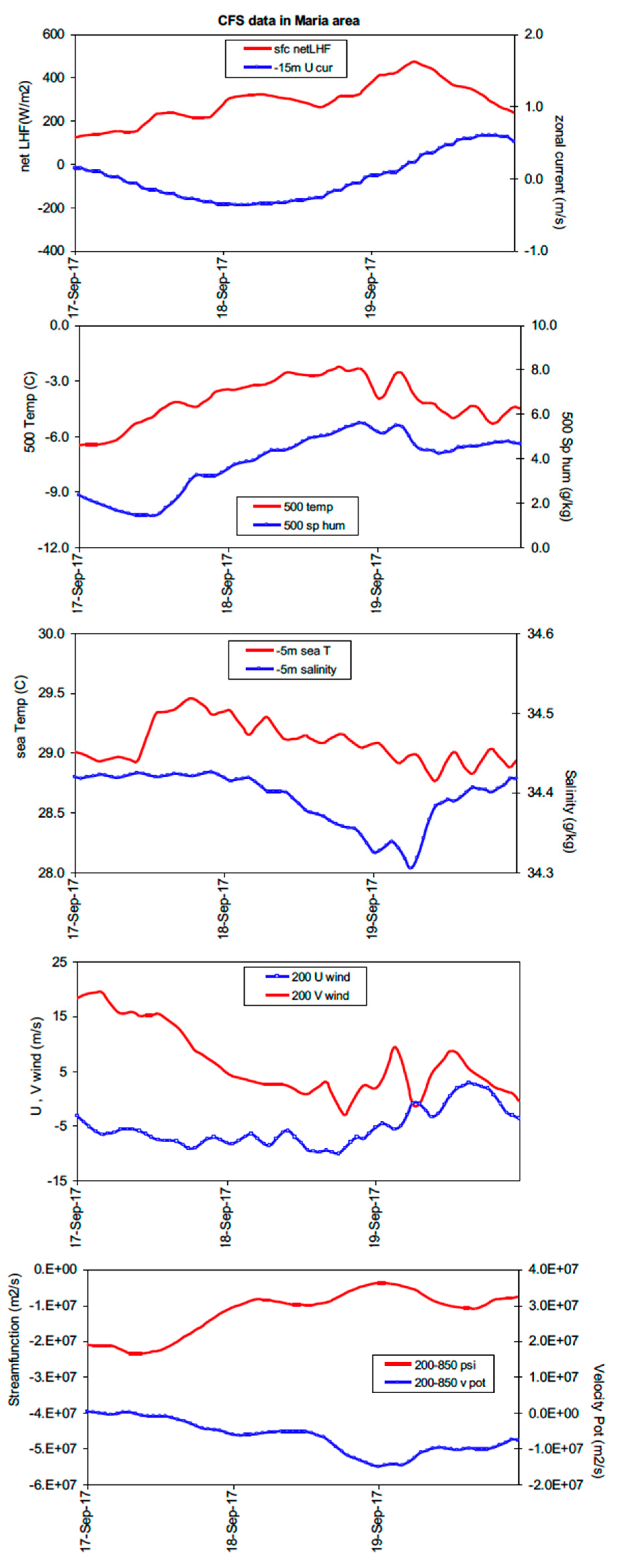
Appendix B
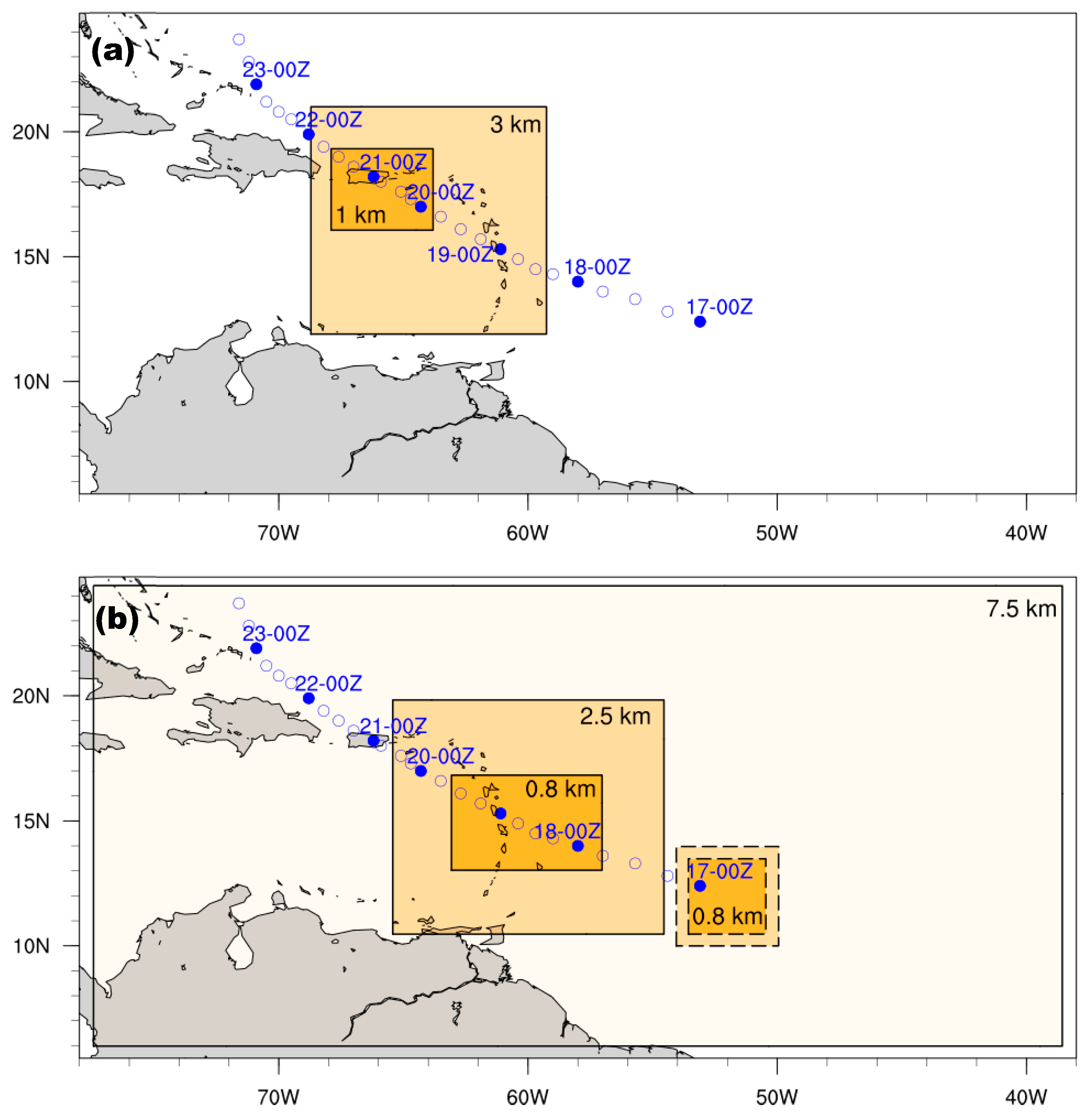
References
- Emanuel, K.A. Increasing destructiveness of tropical cyclones over the past 30 years. Nature 2005, 436, 686–688. [Google Scholar] [CrossRef] [PubMed]
- Webster, P.J.; Holland, G.J.; Curry, J.A.; Chang, H.-R. Changes in tropical cyclone number, duration, and intensity in a warming environment. Science 2005, 309, 1844–1846. [Google Scholar] [CrossRef] [PubMed]
- Aiyyer, A.R.; Thorncroft, C. Climatology of vertical wind shear over the tropical Atlantic. J. Clim. 2006, 19, 2969–2983. [Google Scholar] [CrossRef]
- Franklin, J.L.; McAdie, C.J.; Lawrence, M.B. Trends in track forecasting for tropical cyclones threatening the United States, 1970–2001. Bull. Am. Meteorol. Soc. 2003, 84, 1197–1203. [Google Scholar] [CrossRef]
- DeMaria, M.; Mainelli, M.; Shay, L.K.; Knaff, J.A.; Kaplan, J. Further improvements to the statistical hurricane intensity prediction scheme (SHIPS). Weather Forecast. 2005, 20, 531–543. [Google Scholar] [CrossRef]
- Goerss, J. Tropical cyclone track forecasts using an ensemble of dynamical models. Mon. Weather Rev. 2000, 128, 1187–1193. [Google Scholar] [CrossRef]
- Powell, M.D.; Aberson, S.D. Accuracy of United States tropical cyclone landfall forecasts in the Atlantic basin, 1976–2000. Bull. Am. Meteorol. Soc. 2001, 82, 2749–2767. [Google Scholar] [CrossRef]
- DeMaria, M.; Knaff, J.A.; Sampson, C. Evaluation of long-term trends in tropical cyclone intensity forecasts. Meteor. Atmos. Phys. 2007, 97, 19–28. [Google Scholar] [CrossRef]
- Davis, C.; Wang, W.; Chen, S.S.; Chen, Y.; Corbosiero, K.; DeMaria, M.; Dudhia, J.; Holland, G.; Klemp, J.; Michalakes, J.; et al. Prediction of landfalling hurricanes with the Advanced WRF model. Mon. Weather Rev. 2008, 136, 1990–2005. [Google Scholar] [CrossRef]
- Davis, C.; Wang, W.; Dudhia, J.; Torn, R. Does increased horizontal resolution improve hurricane wind forecasts? Weather Forecast. 2010, 25, 1826–1841. [Google Scholar] [CrossRef]
- Sitkowski, M.; Kossin, J.P.; Rozoff, C.M. Intensity and structure changes during hurricane eyewall replacement cycles. Mon. Weather Rev. 2011, 139, 3829–3847. [Google Scholar] [CrossRef]
- Zhou, X.; Wang, B. Mechanism of concentric eyewall replacement cycles and associated intensity change. J. Atmos. Sci. 2011, 68, 972–988. [Google Scholar] [CrossRef]
- Stern, D.P.; Vigh, J.L.; Nolan, D.S.; Zhang, F. Revisiting the relationship between eyewall contraction and intensification. J. Atmos. Sci. 2015, 72, 1283–1306. [Google Scholar] [CrossRef]
- Rappaport, E.N.; Jiing, J.G.; Landsea, C.W.; Murillo, S.T.; Franklin, J.L. The Joint Hurricane Testbed—Its first decade of tropical cyclone research-to-operations activities revisited. Bull. Am. Meteorol. Soc. 2012, 93, 371–380. [Google Scholar] [CrossRef]
- Cangialosi, J.P.; Landsea, C.W. An examination of model and official National Hurricane Center tropical cyclone size forecasts. Weather Forecast. 2016, 31, 1293–1300. [Google Scholar] [CrossRef]
- Kaplan, J.; DeMaria, M.; Knaff, J.A. A revised tropical cyclone rapid intensification index for the Atlantic and eastern North Pacific basins. Weather Forecast. 2010, 25, 220–241. [Google Scholar] [CrossRef]
- Wang, H.; Wang, Y. A numerical study of Typhoon Megi (2010): Part I: Rapid intensification. Mon. Weather Rev. 2014, 124, 29–48. [Google Scholar] [CrossRef]
- Rogers, R.; Reasor, P.; Lorsolo, S. Airborne Doppler observations of the inner-core structural differences between intensifying and steady-state tropical cyclones. Mon. Weather Rev. 2013, 141, 2970–2991. [Google Scholar] [CrossRef]
- Fovell, R.G.; Corbosiero, K.L.; Kuo, H.C. Cloud microphysics impact on hurricane track as revealed in idealized experiments. J. Atmos. Sci. 2009, 66, 1764–1778. [Google Scholar] [CrossRef]
- Pasch, R.J.; Penny, A.B.; Berg, R. Hurricane Maria 2017; Tropical Cyclone Report; National Hurricane Center: Miami, FL, USA, 5 April 2018; p. 48. Available online: www.nhc.noaa.gov/data/tcr/AL152017_Maria.pdf (accessed on 20 August 2019).
- Jin, H.; Peng, M.S.; Jin, Y.; Doyle, J.D. An evaluation of the impact of horizontal resolution on tropical cyclone predictions using COAMPS-TC. Weather Forecast. 2014, 29, 252–270. [Google Scholar] [CrossRef]
- Alaka, G.J.; Zhang, X.; Gopalakrishnan, S.G.; Goldenberg, S.B.; Marks, F.D. Performance of basin-scale HWRF tropical cyclone track forecasts. Weather Forecast. 2017, 32, 1253–1271. [Google Scholar] [CrossRef]
- Doyle, J.D.; Moskaitis, J.; Hodur, R.; Chen, S.; Jin, H.; Jin, Y.; Komaromi, W.; Reinecke, A.; Wang, S. COAMPS-TC Status and Future Plans. In Proceedings of the 2018 Tropical Cyclone Operations and Research Forum (TCORF)/72nd Interdepartmental Hurricane Conference (IHC), Miami, FL, USA, 13–15 March 2018. [Google Scholar]
- Liu, B.; Mehra, A.; Zhang, Z.; Abarca, S.; Dong, J.; Iredell, D.; Kim, H.-S.; Liu, Q.; Ma, Z.; Sheinin, D.; et al. Verification of 2017 HWRF and HMON performances. In Proceedings of the HFIP Annual Review Meeting, Miami, FL, USA, 8 November 2017. [Google Scholar]
- Landsea, C.W.; Franklin, J.L. Atlantic hurricane database uncertainty and presentation of a new database format. Mon. Weather Rev. 2013, 141, 3576–3592. [Google Scholar] [CrossRef]
- Joyce, R.J.; Janowiak, J.E.; Arkin, P.A.; Xie, P. CMORPH: A method that produces global precipitation estimates from passive microwave and infrared data at high spatial and temporal resolution. J. Hydrometeor. 2004, 5, 487–503. [Google Scholar] [CrossRef]
- Huffman, G.; Bolvin, D.T.; Braithwaite, D.; Hsu, K.; Joyce, R.; Kidd, C.; Nelkin, E.J.; Sorooshian, S.; Tan, J.; Xie, P. NASA Global Precipitation Measurement (GPM) Integrated Multi-Satellite Retrievals V5; Theoretical Basis Document; GSFC: Washington, DC, USA, 7 February 2018; p. 95. Available online: https://pmm.nasa.gov/resources/documents/gpm-integrated-multi-satellite-retrievals-gpm-imerg-algorithm-theoretical-basis- (accessed on 20 August 2019).
- Dee, D.P.; Uppala, S.M.; Simmons, A.J.; Berrisford, P.; Poli, P.; Kobayashi, S.; Andrae, U.; Balmaseda, M.A.; Balsamo, G.; Bauer, D.P.; et al. The ERA-interim reanalysis: Configuration and performance of the data assimilation system. Q. J. R. Meteorol. Soc. 2011, 137, 553–597. [Google Scholar] [CrossRef]
- Gelaro, R.; McCarty, W.; Suárez, M.J.; Todling, R.; Molod, A.; Takacs, L.; Randles, C.A.; Darmenov, A.; Bosilovich, M.G.; Reichle, R.; et al. The Modern-era retrospective analysis for research and applications, version 2 (MERRA2). J. Clim. 2017, 30, 5419–5454. [Google Scholar] [CrossRef]
- Reynolds, R.W.; Smith, T.M.; Liu, C.; Chelton, D.B.; Casey, K.S.; Schlax, M.G. Daily high-resolution-blended analyses for sea surface temperature. J. Clim. 2007, 20, 5473–5496. [Google Scholar] [CrossRef]
- Chassignet, E.P.; Hurlburt, H.E.; Metzger, E.J.; Smedstad, O.M.; Cummings, J.A.; Halliwell, G.R.; Bleck, R.; Baraille, R.; Wallcraft, A.J.; Lozano, C.; et al. US GODAE: Global ocean prediction with the Hybrid coordinate ocean model (Hycom). Oceanography 2009, 22, 64–75. [Google Scholar] [CrossRef]
- Wilson, J.J.W.; Anderson, C.; Baker, M.A.; Bonekamp, H.; Saldana, J.F.; Dyer, R.G.; Lerch, J.A.; Kayal, G.; Gelsthorpe, R.V.; Brown, M.A.; et al. Radiometric calibration of the advanced wind scatterometer radar ASCAT carried onboard the METOP-A satellite. IEEE Trans. Geosci. Remote Sens. 2010, 48, 3236–3255. [Google Scholar] [CrossRef]
- NOAA. The Meteorological Buoy and Coastal Marine Automated Network for the United States; National Academy Press: Washington, DC, USA, 1998; pp. 13–24.
- IOC. The Global Sea-Level Observing System (GLOSS): Implementation Plan; Technical Series 100; UNESCO: Paris, France, 2012; p. 48. Available online: unesdoc.unesco.org/images/0021/002178/217832e.pdf (accessed on 20 August 2019).
- Tolman, H.L. User Manual and System Documentation of WAVEWATCH-III; Technical Note; NCEP: Washington, DC, USA, 2002; p. 139.
- Stephens, G.L.; Vane, D.G.; Boain, R.J.; Mace, G.G.; Sassen, K.; Wang, Z.; Illingworth, A.J.; O’connor, E.J.; Rossow, W.B.; Durden, S.L.; et al. The Cloudsat mission and the A-train: A new dimension of space-based observations of clouds and precipitation. Bull. Am. Meteorol. Soc. 2002, 83, 1771–1790. [Google Scholar] [CrossRef]
- Tucker, C.J.; Pinzon, J.E.; Brown, M.E.; Slayback, D.A.; Pak, E.W.; Mahoney, R.; Vermote, E.F.; El Saleous, N. An extended AVHRR 8 km NDVI dataset compatible with MODIS and SPOT vegetation data. Int. J. Remote Sens. 2005, 26, 4485–4498. [Google Scholar] [CrossRef]
- Hazelton, A.T.; Bender, M.; Morin, M.; Harris, L.; Lin, S. 2017 Atlantic Hurricane Forecasts from a high-resolution version of the GFDL fvGFS model: Evaluation of track, intensity, and structure. Weather Forecast. 2018, 33, 1317–1337. [Google Scholar] [CrossRef]
- Saha, S.; Moorthi, S.; Pan, H.L.; Wu, X.; Wang, J.; Nadiga, S.; Tripp, P.; Kistler, R.; Woollen, J.; Behringer, D.; et al. The NCEP Climate Forecast System reanalysis. Bull. Am. Meteorol. Soc. 2010, 91, 1015–1057. [Google Scholar] [CrossRef]
- Saha, S.; Moorthi, S.; Wu, X.; Wang, J.; Nadiga, S.; Tripp, P.; Behringer, D.; Hou, Y.T.; Chuang, H.Y.; Iredell, M.; et al. The NCEP Climate Forecast System version 2. J Clim. 2014, 27, 2185–2208. [Google Scholar] [CrossRef]
- Davis, C.; Wang, W.; Cavallo, S.; Done, J.; Dudhia, J.; Fredrick, S.; Michalakes, J.; Caldwell, G.; Engel, T.; Ghosh, S.; et al. 2010: High-resolution Hurricane Forecasts. Comput. Sci. Eng. 2011, 13, 22, CISESI-2010-03-0023. [Google Scholar] [CrossRef]
- Hong, S.; Lim, J. The WRF Single-Moment 6-Class Microphysics Scheme (WSM6). J. Korean Meteorol. Soc. 2006, 42, 129–151. [Google Scholar]
- Hong, S.-Y.; Noh, Y.; Dudhia, J. A new vertical diffusion package with an explicit treatment of entrainment processes. Mon. Weather Rev. 2006, 134, 2318–2341. [Google Scholar] [CrossRef]
- Iacono, M.J.; Delamere, J.S.; Mlawer, E.J.; Shephard, M.W.; Clough, S.A.; Collins, W.D. Radiative forcing by long-lived greenhouse gases: Calculations with the AER radiative transfer models. J. Geophys. Res. 2008, 113, D13103. [Google Scholar] [CrossRef]
- Knaff, J.A.; Longmore, S.P.; DeMaria, R.T.; Molenar, D.A. Improved tropical-cyclone flight-level wind estimates using routine infrared satellite reconnaissance. J. Appl. Meteorol. Clim. 2015, 54, 463–478. [Google Scholar] [CrossRef]
- Kain, J.S. The Kain–Fritsch convective parameterization: An update. J. Appl. Meteorol. 2004, 43, 170–181. [Google Scholar] [CrossRef]
- Han, J.; Pan, H. Revision of convection and vertical diffusion schemes in the NCEP global forecast system. Weather Forecast. 2011, 26, 520–533. [Google Scholar] [CrossRef]
- Nakanishi, M.; Niino, H. An improved Mellor–Yamada level-3 model: Its numerical stability and application to a regional prediction of advection fog. Bound. Layer Meteorol. 2006, 119, 397–407. [Google Scholar] [CrossRef]
- Wang, X.; Barker, D.M.; Snyder, C.; Hamill, T.N. A hybrid ETKF–3DVAR data assimilation scheme for the WRF model. part I: Observing system simulation experiment. Mon. Weather Rev. 2008, 136, 5116–5131. [Google Scholar] [CrossRef]
- Holland, G.J. An analytic model of the wind and pressure profiles in hurricanes. Mon. Weather Rev. 1980, 108, 1212–1218. [Google Scholar] [CrossRef]
- Krien, Y.; Arnaud, G.; Cécé, R.; Ruf, C.; Belmadani, A.; Khan, J.; Bernard, D.; Islam, A.; Durand, F.; Testut, L.; et al. Can we improve parametric cyclonic wind fields using recent satellite remote sensing data? Remote Sens. 2018, 10, 1963. [Google Scholar] [CrossRef]
- Green, B.W.; Zhang, F. Impacts of air–sea flux parameterizations on the intensity and structure of tropical cyclones. Mon. Weather Rev. 2013, 141, 2308–2324. [Google Scholar] [CrossRef]
- Tian, X.; Zou, X. Capturing size and intensity changes of Hurricanes Irma and Maria (2017) from polar-orbiting satellite microwave radiometers. J. Atmos. Sci. 2018, 75, 2509–2522. [Google Scholar] [CrossRef]
- George Washington University. Ascertainment of the Estimated Excess Mortality from Hurricane Maria in Puerto Rico; George Washington University: Washington, DC, USA, 2018; p. 69. [Google Scholar]
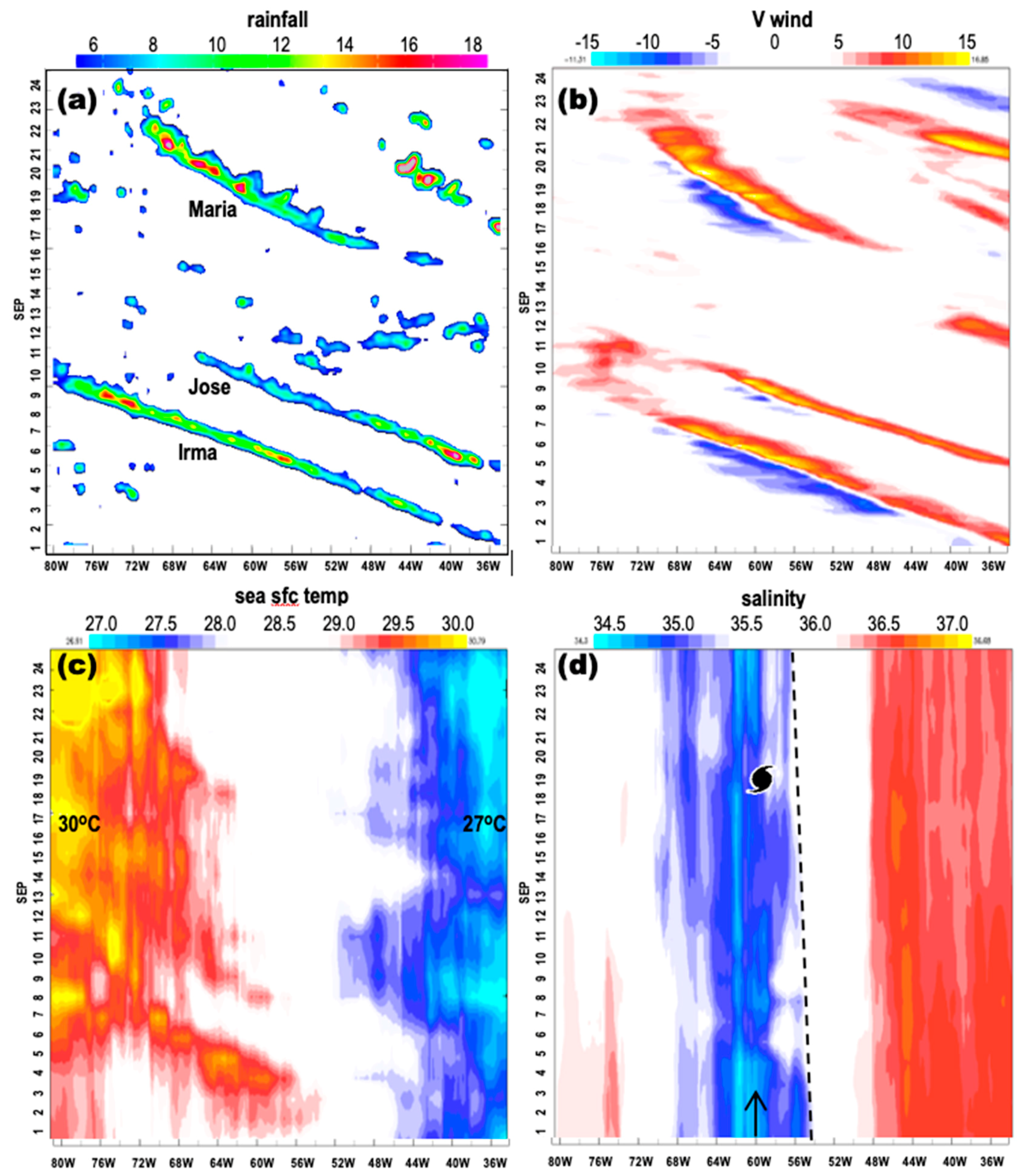

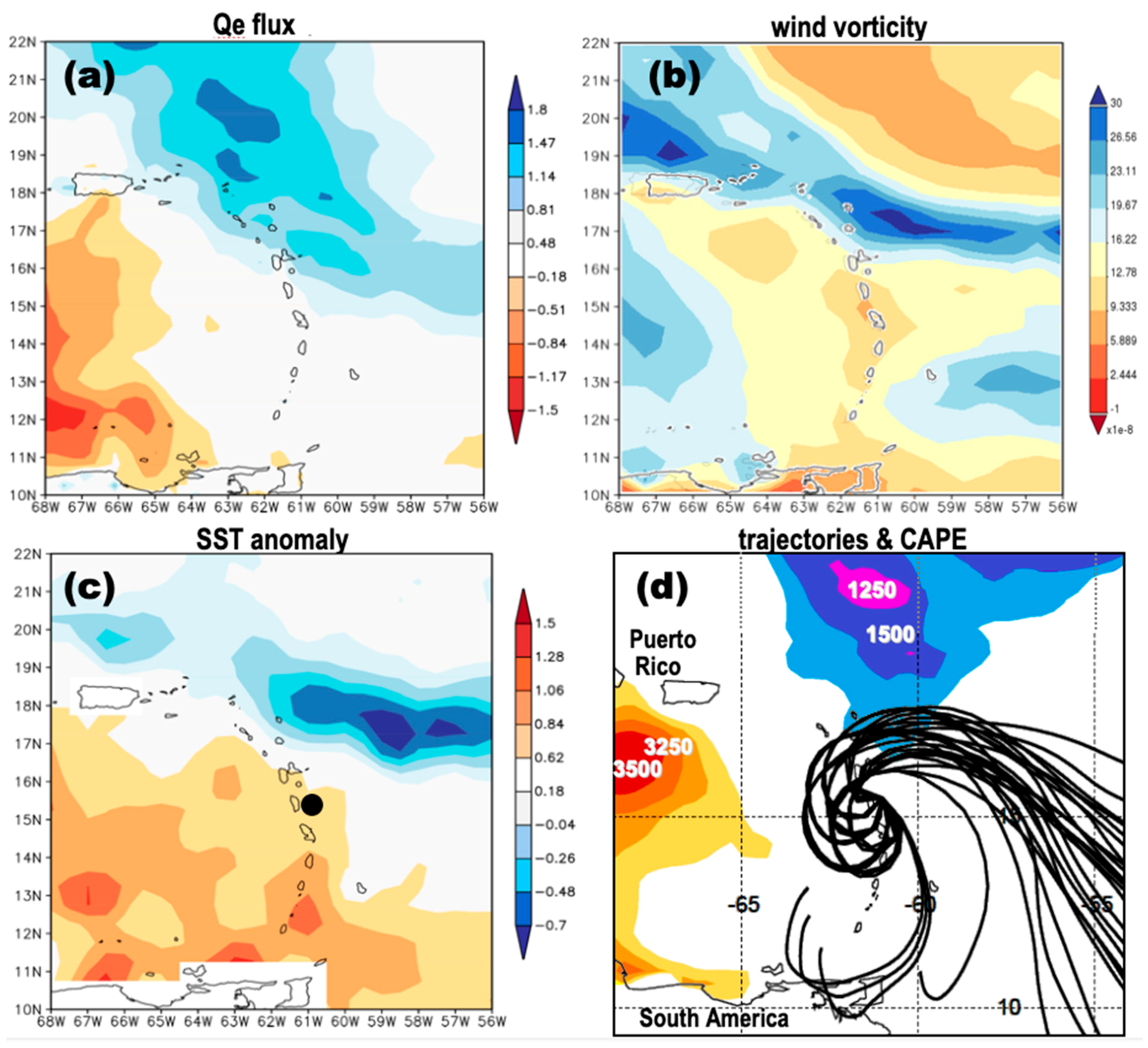
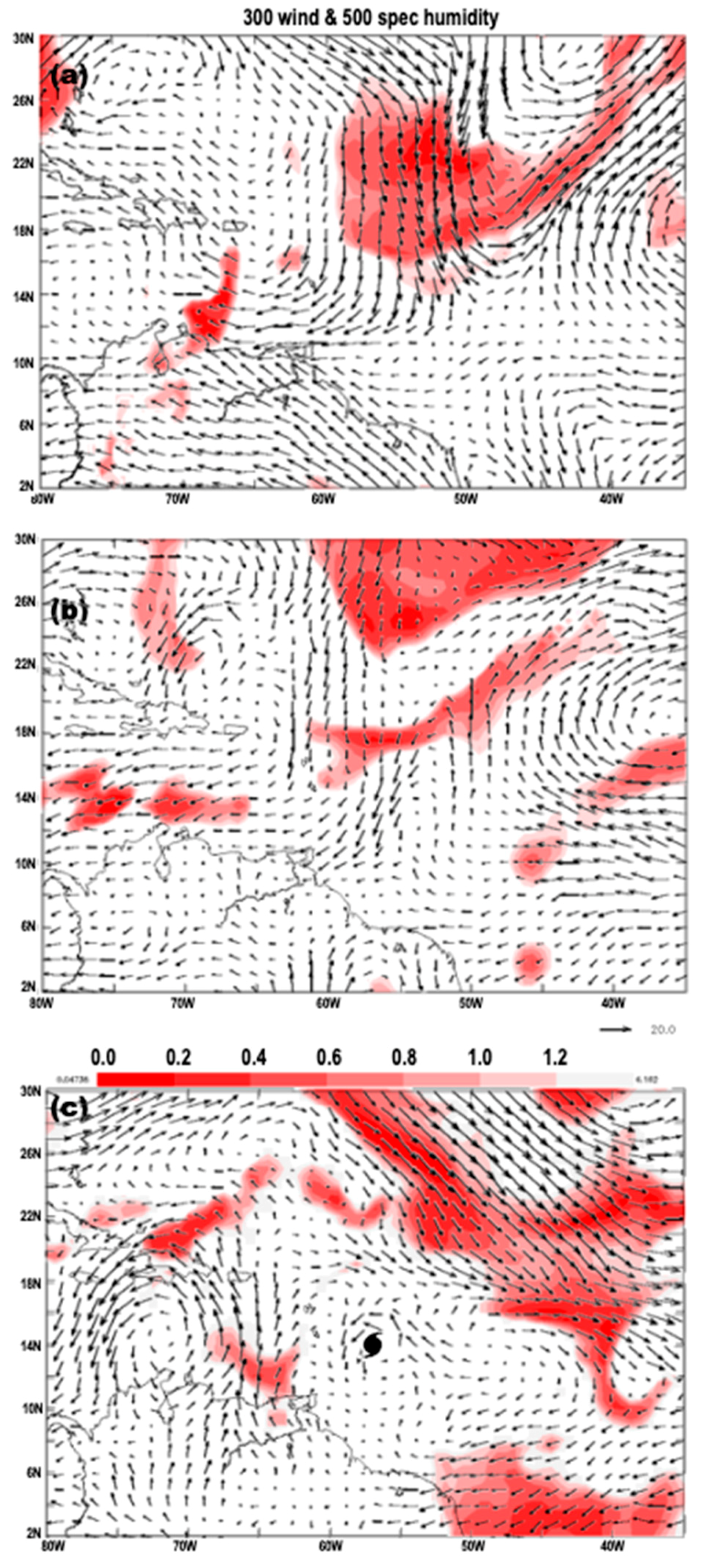



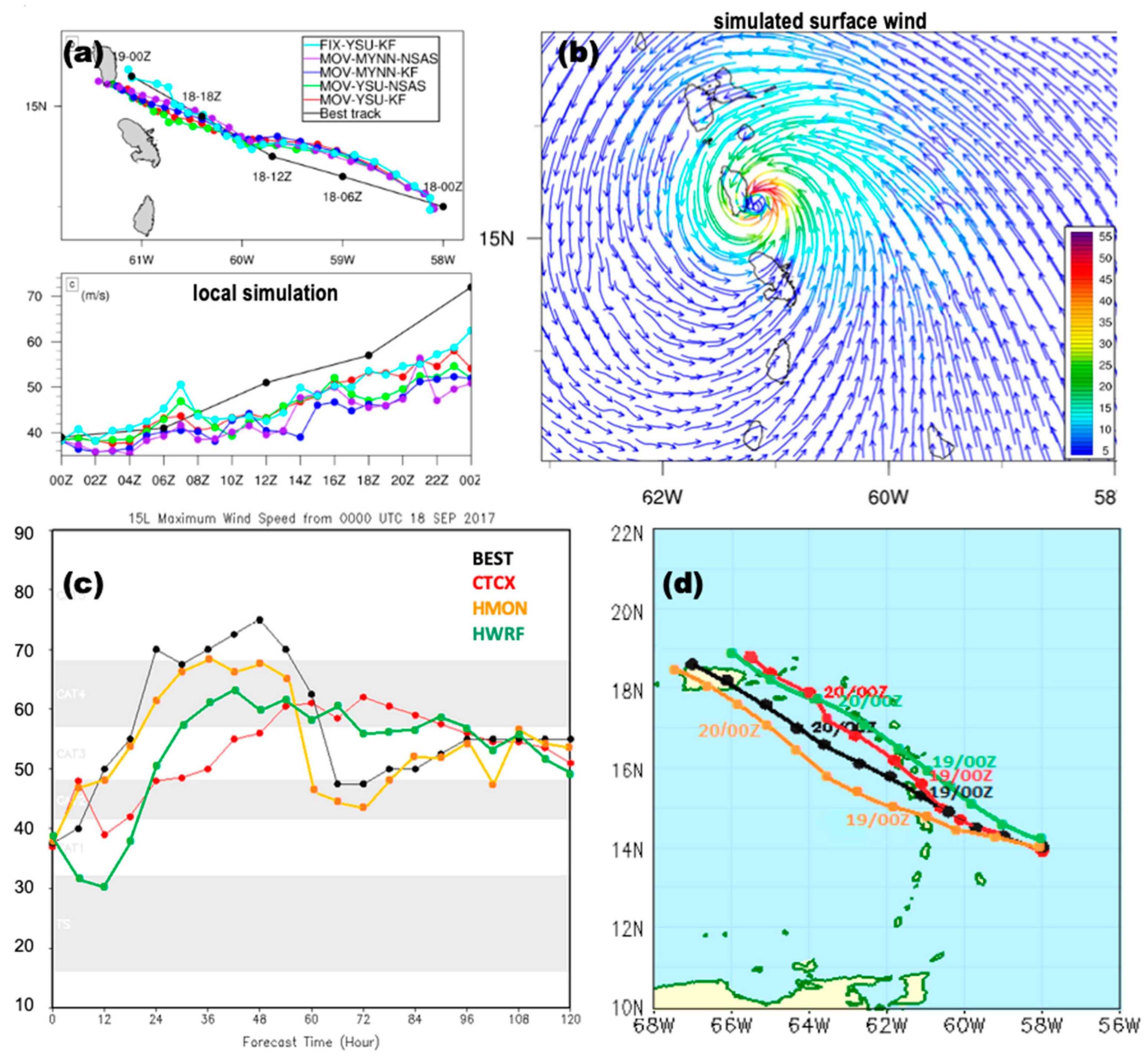
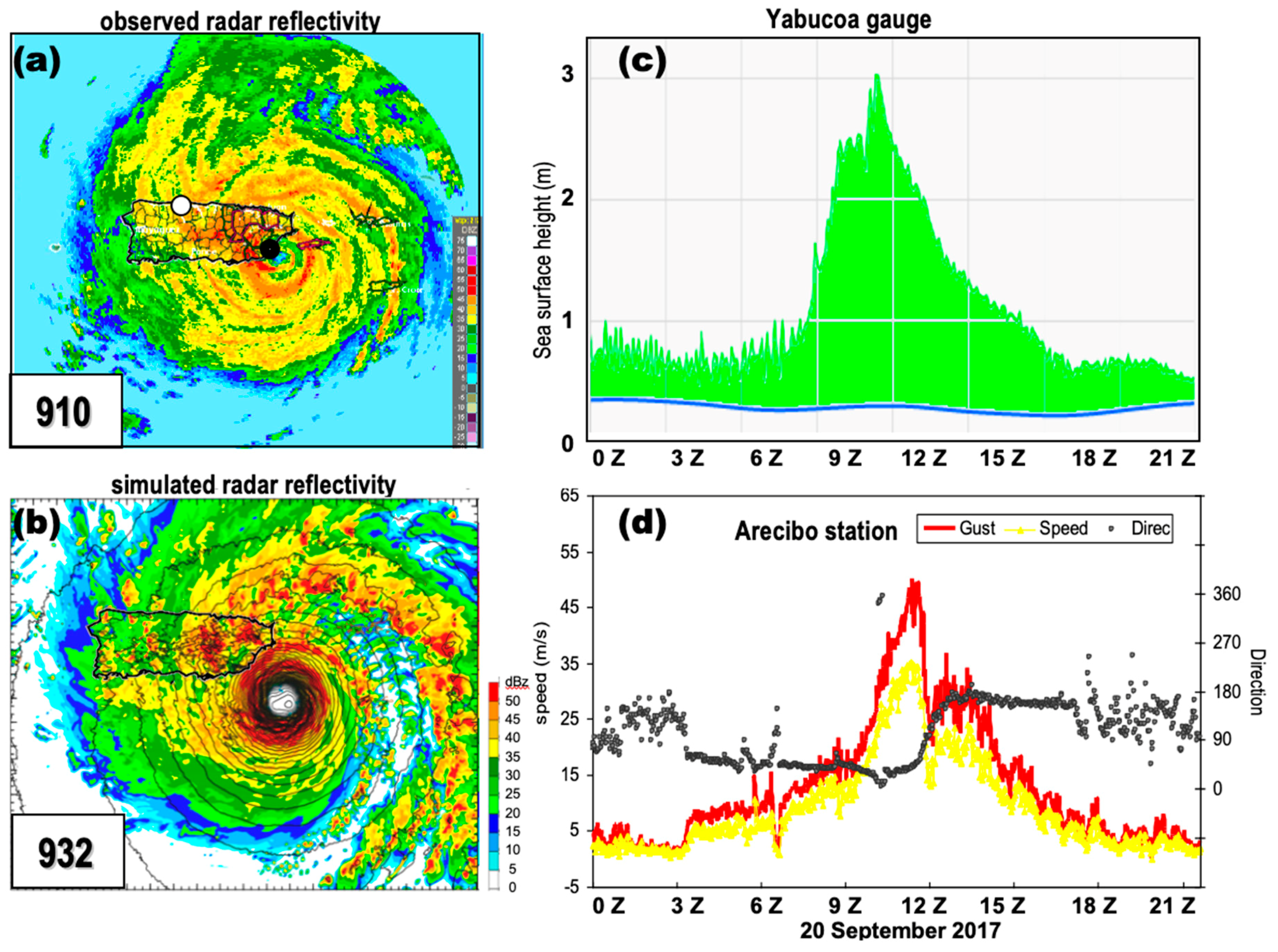
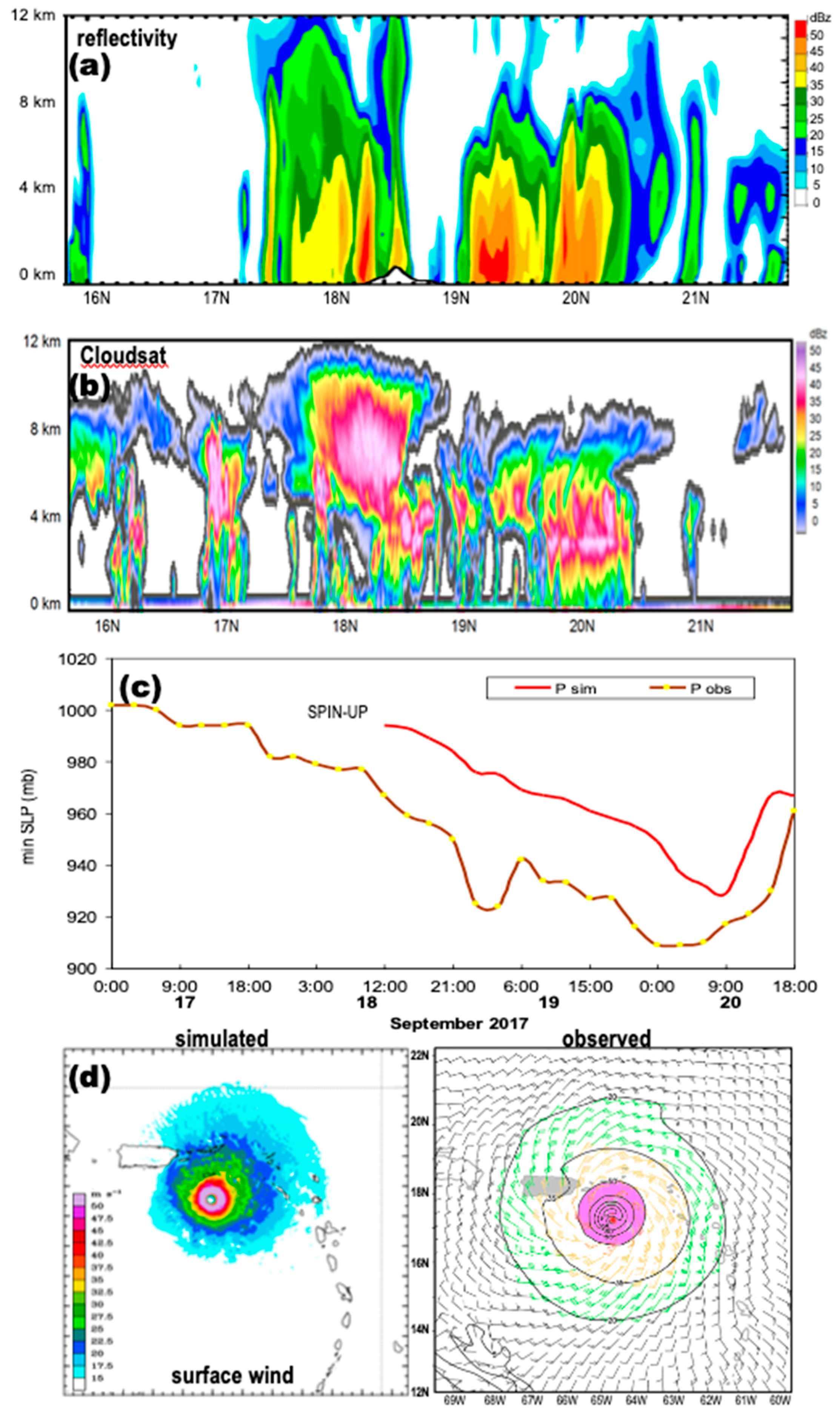

| Day (September) | Time (Z) | Lat | Lon | Wind (kt) | P obs (mb) | RegP sim (mb) |
|---|---|---|---|---|---|---|
| 17 | 0:00 | 12.4 | 53.1 | 45 | 1002 | |
| 17 | 6:00 | 12.8 | 54.4 | 55 | 994 | |
| 17 | 12:00 | 13.3 | 55.7 | 60 | 990 | |
| 17 | 18:00 | 13.6 | 57.0 | 65 | 986 | |
| 18 | 0:00 | 14.0 | 58.0 | 75 | 979 | |
| 18 | 6:00 | 14.3 | 59.0 | 80 | 977 | |
| 18 | 12:00 | 14.5 | 59.7 | 100 | 967 | 994 |
| 18 | 18:00 | 14.9 | 60.4 | 110 | 956 | 989 |
| 19 | 0:00 | 15.3 | 61.1 | 145 | 924 | 976 |
| 19 | 6:00 | 15.7 | 61.9 | 135 | 940 | 969 |
| 19 | 12:00 | 16.1 | 62.7 | 140 | 931 | 965 |
| 19 | 18:00 | 16.6 | 63.5 | 145 | 920 | 958 |
| 20 | 0:00 | 17.0 | 64.3 | 150 | 909 | 949 |
| 20 | 6:00 | 17.6 | 65.1 | 140 | 913 | 932 |
| 20 | 12:00 | 18.2 | 66.2 | 115 | 935 | 948 |
| 20 | 18:00 | 18.6 | 67.0 | 95 | 959 | 967 |
| MOV-MYNN-NSAS | MOV-MYNN- KF | MOV-YSU-NSAS | MOV-YSU-KF | FIX-YSU- KF | |
|---|---|---|---|---|---|
| 24H-MEAN TRACK ERROR (KM) | 25 | 20 | 20 | 19 | 21 |
| 00Z 19 TRACK ERROR (KM) | 36 | 20 | 22 | 18 | 8 |
| 24H-MEAN INTENSITY BIAS (M/S) | −9 | −9 | −7 | −6 | −4 |
| 00Z 19 INTENSITY BIAS (M/S) | −21 | −20 | −20 | −18 | −10 |
| Initialization Data | 17-Sep | 06Z | 12Z | 18Z | 18-Sep | 06Z | 12Z | 18Z | 19-Sep | 06Z | 12Z | 18Z | 20-Sep | 06Z |
|---|---|---|---|---|---|---|---|---|---|---|---|---|---|---|
| LAT (deg) | 12.1 | 12.7 | 13.2 | 13.5 | 13.9 | 14.3 | 14.4 | 14.8 | 15.2 | 15.8 | 16 | 16.5 | 16.9 | 17.5 |
| LON (deg) | −53.2 | −54.3 | −55.7 | −57 | −58 | −59 | −59.7 | −60.4 | −61.1 | −62.1 | −62.7 | −63.6 | −64.3 | −65.1 |
| maxWind (knot) | 40 | 55 | 54 | 64 | 74 | 78 | 97 | 107 | 136 | 130 | 135 | 140 | 145 | 135 |
| Radius (km) | 56 | 49 | 97 | 100 | 96 | 99 | 121 | 119 | 145 | 96 | 118 | 143 | 138 | 143 |
| SLP_min (hPa) | 1008 | 996 | 997 | 987 | 978 | 974 | 955 | 944 | 916 | 921 | 917 | 910 | 903 | 914 |
| Shear U (knot) | 0.6 | 4.0 | 7.3 | 5.0 | 6.5 | 5.6 | 1.6 | −3.2 | −4.5 | −1.2 | −1.9 | −3.9 | −1.5 | 3.6 |
| H_spd (knot) | 9 | 10 | 12 | 7 | 10 | 8 | 8 | 5 | 7 | 5 | 9 | 7 | 9 | 9 |
| H_hdg (deg) | 285 | 301 | 291 | 276 | 288 | 281 | 299 | 301 | 297 | 309 | 304 | 300 | 304 | 300 |
| SST (degC) | 29.1 | 28.6 | 28.7 | 28.8 | 28.9 | 28.7 | 29 | 29.4 | 29.4 | 29.4 | 29.4 | 29.5 | 29.5 | 29.5 |
| Prec Wtr (mm) | 57 | 57 | 58 | 58 | 58 | 58 | 59 | 60 | 58 | 58 | 58 | 59 | 57 | 57 |
| 850 vort (e5/sec) | 19 | 0 | −2 | 14 | 22 | 17 | 7 | 21 | 23 | 21 | 27 | 40 | 47 | 62 |
| 200 div (e5/sec) | 48 | 46 | 39 | 59 | 55 | 47 | 54 | 103 | 92 | 82 | 79 | 64 | 58 | 40 |
© 2019 by the authors. Licensee MDPI, Basel, Switzerland. This article is an open access article distributed under the terms and conditions of the Creative Commons Attribution (CC BY) license (http://creativecommons.org/licenses/by/4.0/).
Share and Cite
Jury, M.R.; Chiao, S.; Cécé, R. The Intensification of Hurricane Maria 2017 in the Antilles. Atmosphere 2019, 10, 590. https://doi.org/10.3390/atmos10100590
Jury MR, Chiao S, Cécé R. The Intensification of Hurricane Maria 2017 in the Antilles. Atmosphere. 2019; 10(10):590. https://doi.org/10.3390/atmos10100590
Chicago/Turabian StyleJury, Mark R., Sen Chiao, and Raphael Cécé. 2019. "The Intensification of Hurricane Maria 2017 in the Antilles" Atmosphere 10, no. 10: 590. https://doi.org/10.3390/atmos10100590
APA StyleJury, M. R., Chiao, S., & Cécé, R. (2019). The Intensification of Hurricane Maria 2017 in the Antilles. Atmosphere, 10(10), 590. https://doi.org/10.3390/atmos10100590





